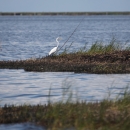The purpose of this draft Restoration Plan/Environmental Assessment (RP/EA) is to describe how a Trustee for the Arrowhead Refinery Natural Resource Damage Assessment and Restoration (NRDAR), the Department of Interior represented by the United States Fish and Wildlife Service, will utilize funds obtained through a claim for natural resource damages for the restoration of natural resources injured by the release of hazardous substances at the Arrowhead Refinery Site. The Arrowhead Refinery Site is located within the St. Louis River watershed in Hermantown, St. Louis County, Minnesota. The former waste oil recycling facility operated from 1961-1977 and generated approximately 7,000 cubic yards of highly acidic, metal-laden sludge. The sludge was disposed of on the property and eventually migrated off site, contaminating wetland habitat south of the facility. Injuries to natural resources within the 40 acre Site include migratory birds and their supporting habitats from exposure to polychlorinated biphenyls, phenols, cyanide, lead, barium, arsenic, cadmium, chromium, and selenium.
The State of Minnesota, represented by the Minnesota Department of Natural Resources and the Minnesota Pollution Control Agency and the United States Fish and Wildlife Service developed a claim for natural resource damages at the Site and recovered their claim through a Consent Decree. The Arrowhead Refining Company and other responsible parties were required to pay $91,000 for damages associated with the palustrine forested wetland and $62,400 for damages associated with the palustrine emergent wetland. The Minnesota Department of Natural Resources completed the palustrine forested wetland restoration in 1997. Due to the accumulation of interest, the Service now has approximately $100,000 for the restoration of migratory birds and associated palustrine emergent wetland habitat and related administrative costs. Due to extensive injury and remedial actions at the site, the Trustee determined off-site restoration is required.
Consistent with the United States Department of the Interior Comprehensive Environmental Response, Compensation, and Liability Act NRDAR regulations and the National Environmental Policy Act, the Trustee evaluated three alternatives for completing the type of restoration sufficient to compensate the public for natural resource injuries. Based on selection factors including location, technical feasibility, cost effectiveness, provision of natural resource services similar to those lost due to contamination, and net environmental consequences, the Trustees have identified Alternative Three as the preferred alternative. Alternative Three consists of the restoration and enhancement of Grassy Point, a 160-acre impaired wetland complex adjacent to the St. Louis River and approximately 5 miles from Lake Superior. This alternative was evaluated in the St. Louis River Interlake Duluth Tar Final RP/EA1. The specific restoration actions being considered in this draft RP/EA include non-native vegetation management and replanting the area with native trees, shrubs, forbs, and grasses. If selected, this alternative will provide foraging and nesting habitat for migratory birds, the injured resource.
This draft RP/EA will be available for review and comment for a period of 30 days in accordance with 43 Code of Federal Regulations (C.F.R.) § 11.81(d)(2). The Trustee will address and respond to public comments as part of the final RP/EA.




